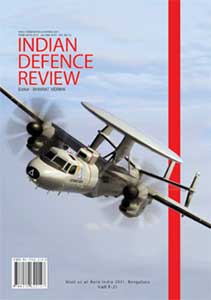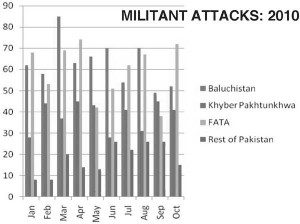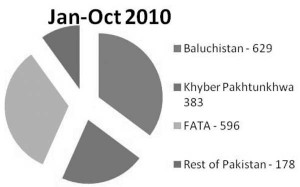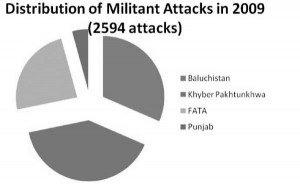Imagine a country where every week one or two young men – mostly in their teens, blow themselves up as suicide bombers in senseless acts of violence! Where targeted killings take place almost on a daily basis! Where half a dozen persons are kidnapped and three to four are beheaded by militants every month! Where each day of the year, on average, bears witness to at least four other types of terrorist violence – bomb blasts, rocket attacks, land mine explosions, grenade attacks or improvised explosive device detonations!
Welcome to Pakistan!
The violence which afflicts Pakistani society is slowly reaching endemic proportions and turning the situation around may soon cease to be a possibility. The first ten months of 2010 have seen a total of 1786 attacks carried out by militants – a staggering figure indeed. Add to this another 1,078 incidents of violence to include clashes between security forces and militants, operational attacks by security forces (including drone attacks), political and ethnic violence, border clashes and inter-tribal clashes and the full impact of violence levels in Pakistan assume numbing proportions. This violence has led to the death of 8,702 people with another 8,943 people being injured. The figures for violence levels in 2009 are even higher. A total of 3,817 attacks of all types took place over the year (militant attacks – 2594) in which 12,625 people were killed and 12,793 were injured1. The consistency of such high levels of violence begs the question – Will Pakistan implode or will Pakistan pull through? The answer will not easily be forthcoming.
Allah of course can save the nation, but what if Allah chooses to stay neutral? In the ultimate analysis, it is the people of Pakistan who have to rise to set right the destiny of their nation.
Of the four provinces of Pakistan, Baluchistan is beset with insurgency and Khyber Pakhtunkhwa is literally a war zone. In the Federally Administered Tribal Areas (FATA), the situation is more explosive than that existing in Khyber Pakhtunkhwa. East of the Indus, fundamentalist forces have spread their roots in the provinces of Punjab and Sind though violence levels here are small as compared to the other two provinces. But still the fear of terror has rendered the cities in Pakistan into virtual fortresses. The port city of Karachi is also beset with chronic ethnic violence which is an off shoot of a historical legacy dating back to the partition. Indeed, there is no part of Pakistan which has remand unaffected by militant or ethnic or sectarian/religious induced violence. The signs of an impending implosion in the country are all too real to be ignored any longer.
Violence in Pakistan is a result of some concomitant factors, chief among them being the ongoing war in neighbouring Afghanistan, the lack of democratic structures within Pakistan, a failing economy and a skewed education policy. The education system in Pakistan has provided fertile grounds for the spread of radicalism within society. Pakistan’s educational curriculum which was relatively forward looking with some emphasis on multiculturalism and a nationalism perceived in futuristic and modernist terms was revised by Zia ul Haq to conform to Islamic thought, precepts and fundamentalist religious ideological orientation. History and geography, which were separate and distinct subjects, were amalgamated as Pakistan Studies and made compulsory for all students from the ninth grade through the first year of college, including engineering and medical schools.
The teaching of History was distorted, hatred for India was inculcated and ‘Islamiyat’ was made compulsory with specific directions being given for religious and ideological content… “To demonstrate that the basis of Pakistan is not to be founded in racial, linguistic, or geographical factors, but, rather, in the shared experience of a common religion…To guide students towards the ultimate goal of Pakistan—the creation of a completely Islamised State” (University Grants Commission directive, 1983).
A radicalised Pakistan may well result in the movement of millions of Pakistans more liberal elements to seek shelter in India. How such a situation is to be countered is something which has to be thought out and factored into a future security calculus.
In the process the cultures and histories of sub nationalities like the Baloch, Pathan and Sindhi were suppressed and an irrational paradigm denied the existence of cultural differences on the assumption that religion would bridge the gap between sub national identities. The strategies that Zia appropriated and propagated were based on narrow, medieval interpretations of Islam, which resulted in gender biased attitudes and policies and militarised exhortations to take up arms for the sake of jihad. This stratification of Pakistan’s educational infrastructure has created significant divergences of worldviews with Madrassa students tending to gravitate more toward jihad. Public school or Urdu-medium students too have imbibed radical ideas but to a lesser extent. The small group of private sector educated elite children have more leeway for objective thinking, but tend to relate little with the two more mainstream student streams.
The educational system has therefore contributed in large measure to the polarisation of society and the Jihadi mindsets. The children who were born when Zia revised the educational curriculum are now young men steeped in ideology and the primacy of religion. The narrative they listen to is grounded in religion and championed by militant groups, vying for their brand of Islam predominant. The progressive and secular narrative of the liberal elements in society has retreated from the national discourse. A reversal of the national narrative would involve reversing the entire socio-cultural, religious and political discourse – a formidable task indeed!
The ongoing conflict in Afghanistan has further accentuated the polarisation process. Following the fall of the Taliban regime in 2001, the erstwhile leadership elements in Afghanistan relocated to Baluchistan, FATA and Khyber Pakhtunkhwa. Prominent among these are: the Quetta Shura Taliban (QST) of Mullah Mohammed Omar, the Haqqani network and the Hizb-e Islami-Gulbuddin. The Pakistan Taliban (a home grown organisation) also came into being in this period called the Tehrik-e-Taliban Pakistan or the TTP. Formed in 2007 by the late Baitullah Mehsud in South Waziristan, the group is currently led by Hakimullah Mehsud, and poses a serious challenge to the Pakistani state. Efforts by the Pakistan Army to eliminate the TTP have proved futile despite the use of air and heavy artillery.
| Editor’s Pick |
Earlier, in 1992, another radical group, the Tehreek-e-Nafaze-e-Shariat-e-Mohammadi (TNSM) was formed with the avowed aim of imposing Sharia in all of Pakistan. Though banned by Musharraf in 2002, the rebel group had taken control of most of Swat by 2007. While it has been cleared from the Valley by continuous military operations, it has not been eliminated and remains active in the region. The brutal handling of the conflict by security forces against militant groups in FATA and Khyber Pakhtunkhwa has led to the destruction of entire villages and rendered more than a million people homeless.
Pakistan’s fight against terrorism is handicapped by conflicting notions and imperatives. The desire to support the Afghan Taliban to retain influence in a future Afghanistan dispensation, devoid of US presence makes her an unwilling partner in the war against terror. The TTP is targeted but there is a marked reluctance to take on Afghan militant groups. At home, Pakistan continues to support and nurture a wide variety of terrorist organisations such as the Lashkar-e-Taiba, Jaish-e-Mohammad, Harkat-ul-Jihad-al-Islami and the Hizbul Mujahideen which were created by Pakistani intelligence to fight against India’s interests in Kashmir and are considered as strategic assets. These groups are now not fully under the control of their mentors and often team up with Pashtun groups and the Pakistani Taliban in actions inimical to Pakistani interests.
The educational system has therefore contributed in large measure to the polarisation of society and the Jihadi mindsets.
The country’s economic indicators also do not present an encouraging picture. The last three years have witnessed a slow growth rate of about 2 to 3 percent with inflation as high as 10 to 15 percent. The country’s economy remains vulnerable to internal and external shocks due to internal security concerns and the global financial crises. In October 2008, Pakistan entered into a 23-month Stand-By Arrangement with the IMF for a USD 11.3 billion loan in order to keep the country solvent and to support its foreign exchange reserves, which had fallen to precariously low levels. Pakistan remains dependent on IMF and other international assistance for budgetary support and to keep the country solvent.
Pakistan’s manufacturing sector accounts for about 25 percent of GDP. Cotton textile production and apparel manufacturing are Pakistan’s largest industries, accounting for about 51.4 percent of total exports. However, the ongoing energy crisis and security concerns, together with a decline in global demand, have hampered Pakistan’s textile-reliant export base. The floods which occurred in mid 2010 also played havoc with the economy.
 This time around, foreign aid to combat the tragedy has not been as forthcoming as witnessed when the country was hit by a severe earthquake a few years earlier. Pakistan’s search for additional foreign direct investment has been hampered by concerns about the security situation, domestic and regional political uncertainties, and questions about judicial transparency. Poor economic indicators further strain the credibility of the government leading to exacerbating existing fissiparous tendencies.At the strategic level, the US will begin the pull out of its forces from Afghanistan in 2011 as announced by President Obama in his address at the US military Academy at West Point in December 2009. This is however likely to be a token gesture, as complete withdrawal will depend on the ability of the Afghanistan government and its security forces to tackle terrorist forces within Afghanistan and keep Al Qaeda out of any future security calculation. As the likelihood of such an outcome in the near future is remote it would dictate prolonged US military presence in Afghanistan which may not be viewed favourably by US public opinion.
This time around, foreign aid to combat the tragedy has not been as forthcoming as witnessed when the country was hit by a severe earthquake a few years earlier. Pakistan’s search for additional foreign direct investment has been hampered by concerns about the security situation, domestic and regional political uncertainties, and questions about judicial transparency. Poor economic indicators further strain the credibility of the government leading to exacerbating existing fissiparous tendencies.At the strategic level, the US will begin the pull out of its forces from Afghanistan in 2011 as announced by President Obama in his address at the US military Academy at West Point in December 2009. This is however likely to be a token gesture, as complete withdrawal will depend on the ability of the Afghanistan government and its security forces to tackle terrorist forces within Afghanistan and keep Al Qaeda out of any future security calculation. As the likelihood of such an outcome in the near future is remote it would dictate prolonged US military presence in Afghanistan which may not be viewed favourably by US public opinion.
The possibility of partitioning Afghanistan has again been suggested by Robert Blackwill, a former US ambassador to India, as a way out. Blackwill argues that de facto partition offers the Obama administration the best available alternative to strategic defeat. The essence of Blackwill’s proposal is: ‘Washington should accept that the Taliban will inevitably control most of the Pashtun south and east and that the price of forestalling that outcome is far too high for Americans to continue paying. The United States and its partners should stop fighting and dying in the Pashtun homeland and let the local correlation of forces take its course – while deploying US air power and Special Forces to ensure that the north and west of Afghanistan do not succumb to the Taliban’.
“¦the US will begin the pull out of its forces from Afghanistan in 2011 as announced by President Obama in his address at the US military Academy at West Point in December 2009. This is however likely to be a token gesture”¦
Blackwill’s proposal has come under tremendous criticism both within the United States as well as sections of the diplomatic and strategic community in India. But the possibility of partitioning Afghanistan on ethnic lines is not such a far-fetched scenario and may well be the silver bullet which brings peace to the region. In any case, India needs to seriously consider the possibility and be prepared for likely fallouts should such an outcome come about.
A common refrain in strategic circles is a reiteration that the days of map making are over and that partitioning Afghanistan will not be in India’s interest as it will promote greater regional instability. While this position can be challenged, the fact remains that India is not a player in the decision making process to decide the future of Afghanistan and can do precious little to affect any outcome. But, should a partitioning take place, a certain outcome will be a demand of the Pashtun’s on either side of the Durand Line to be united in a common Pashtun homeland. The Government of Afghanistan has never accepted the Durand Line and on the ground its applicability is followed only in its breach. The Pakistan Army will be hard put to ensure its writ in the region with 15 percent of its army being drawn from the area.
Negation of the Durand line will bring to an end the artificial partitioning of the Pashtun people and will undo the injustice caused more than a century ago in dividing a people based on geo strategic interests that existed at that time in what was called the Great Game. It must also be remembered that the term “Pakhto” or “Pashto” from which the Pashtuns derive their name is not merely the name of their language, but is synonymous with a pre-Islamic honor code formally known as Pashtunwali (or Pakhtunwali). Pashtunwali governs and regulates nearly all aspects of Pashtun life ranging from tribal affairs to individual honour and behavior. A partitioning of Afghanistan into a Pashtun held South and East and a non Pashtun North and West will inevitably lead to the merger of Khyber Pakhtunkhwa and FATA into a larger Pashtun homeland. The outcome will be strategically beneficial for India.
 The situation in Baluchistan is also volatile. The pursuit for freedom started soon after the province was forcibly annexed by the Pakistan military in 1948 culminating in a war of independence in 1973. It took the Pakistan military five years of bitter conflict to quell the Baluchis. But the aspirations for independence have not died and have resulted in an ongoing insurgency in the region. Nearly 150,000 military troops are stationed in Baluchistan along with over 40,000 troops of the frontier constabulary but this has not resulted in a decrease in violence levels. Of the 1786 attacks carried out by militants in the first ten months of 2010, Baluchistan accounted for 629 attacks – an average of two per day. This figure does not include clashes between security forces and militants, attacks by security forces, drone attacks etc.The situation in 2009 was no better. A comparison of the figures for attacks carried out by militants in 2009 and the first ten months of 2010 are given below.
The situation in Baluchistan is also volatile. The pursuit for freedom started soon after the province was forcibly annexed by the Pakistan military in 1948 culminating in a war of independence in 1973. It took the Pakistan military five years of bitter conflict to quell the Baluchis. But the aspirations for independence have not died and have resulted in an ongoing insurgency in the region. Nearly 150,000 military troops are stationed in Baluchistan along with over 40,000 troops of the frontier constabulary but this has not resulted in a decrease in violence levels. Of the 1786 attacks carried out by militants in the first ten months of 2010, Baluchistan accounted for 629 attacks – an average of two per day. This figure does not include clashes between security forces and militants, attacks by security forces, drone attacks etc.The situation in 2009 was no better. A comparison of the figures for attacks carried out by militants in 2009 and the first ten months of 2010 are given below.
In June 2010, Mehran Baluch, son of the legendary Baluch leader Nawab Khair Baksh Marri speaking at a conference organised by Interfaith International at Geneva stated… ‘let me assure whosoever matters that the armed boys of Pindi and Islamabad – who are also called the Taliban in uniform — will have to respect the concept of mine and thine as the Baloch people are resolved to undo the Pakistani conquest of their homeland on March 27, 1948…when the desire of freedom makes its place in the heart of the masses it becomes a material force no power on earth can defeat.
Baluchistan is sitting on a volcano ready to explode. If Khyber Pakhtunkhwa and FATA merge into a larger Pashtun reality, it would be but a matter of time that Baluchistan will get its independence”¦
The 20 million Baloch people shall prevail.” Baluchistan is sitting on a volcano ready to explode. If Khyber Pakhtunkhwa and FATA merge into a larger Pashtun reality, it would be but a matter of time that Baluchistan will get its independence and the might of the Pakistan’s armed forces will not be able to prevent such an outcome.
If Pakistan does balkanize, what then will be the status of Sind and Punjab? Both these provinces have complementary interests and are unlikely to go their separate ways should Pakistan balkanize. Neither will Pakistan Occupied Kashmir nor Gilgit-Baltistan. Pakistan’s nuclear assets will be safe in the hands of the ruling elite but the military threat will all but cease on India’s Western front. However, the threat to India is likely to take on a different hue. A radicalised Pakistan may well result in the movement of millions of Pakistan’s more liberal elements to seek shelter in India. How such a situation is to be countered is something which has to be thought out and factored into a future security calculus. Another major concern would be limiting the influence of radical Islamic ideology within India’s large Muslim population. Counter measures would lie in the realm of education curriculum, promotion of gender equality and economic development.
 Finally, can such a scenario be avoided? The answer is yes but it would require drastic course corrections within Pakistan in the nature of its polity, its handling of the minorities and a drastic course correction in its educational curriculum. Traditionally, Pakistan in popular perception is being run by the three “A’s”- America, Army and Allah. The US can give massive doses of aid but its efforts are unlikely to be able to set the requisite course corrections. The Pakistan Army will do nothing to subvert its own interests and will do everything to preserve the status quo. Allah of course can save the nation, but what if Allah chooses to stay neutral? In the ultimate analysis, it is the people of Pakistan who have to rise to set right the destiny of their nation. It is a tall ask but not outside the realms of possibility. The people have to act fast for time is running out and Pakistan may soon reach the point of no return.
Finally, can such a scenario be avoided? The answer is yes but it would require drastic course corrections within Pakistan in the nature of its polity, its handling of the minorities and a drastic course correction in its educational curriculum. Traditionally, Pakistan in popular perception is being run by the three “A’s”- America, Army and Allah. The US can give massive doses of aid but its efforts are unlikely to be able to set the requisite course corrections. The Pakistan Army will do nothing to subvert its own interests and will do everything to preserve the status quo. Allah of course can save the nation, but what if Allah chooses to stay neutral? In the ultimate analysis, it is the people of Pakistan who have to rise to set right the destiny of their nation. It is a tall ask but not outside the realms of possibility. The people have to act fast for time is running out and Pakistan may soon reach the point of no return.
Notes
- All data of terrorist attacks and casualty figures given in this paragraph have been compiled from figures published by Pakistan Institute of Peace Studies (PIPS). PIPS is an independent think tank in Pakistan.






